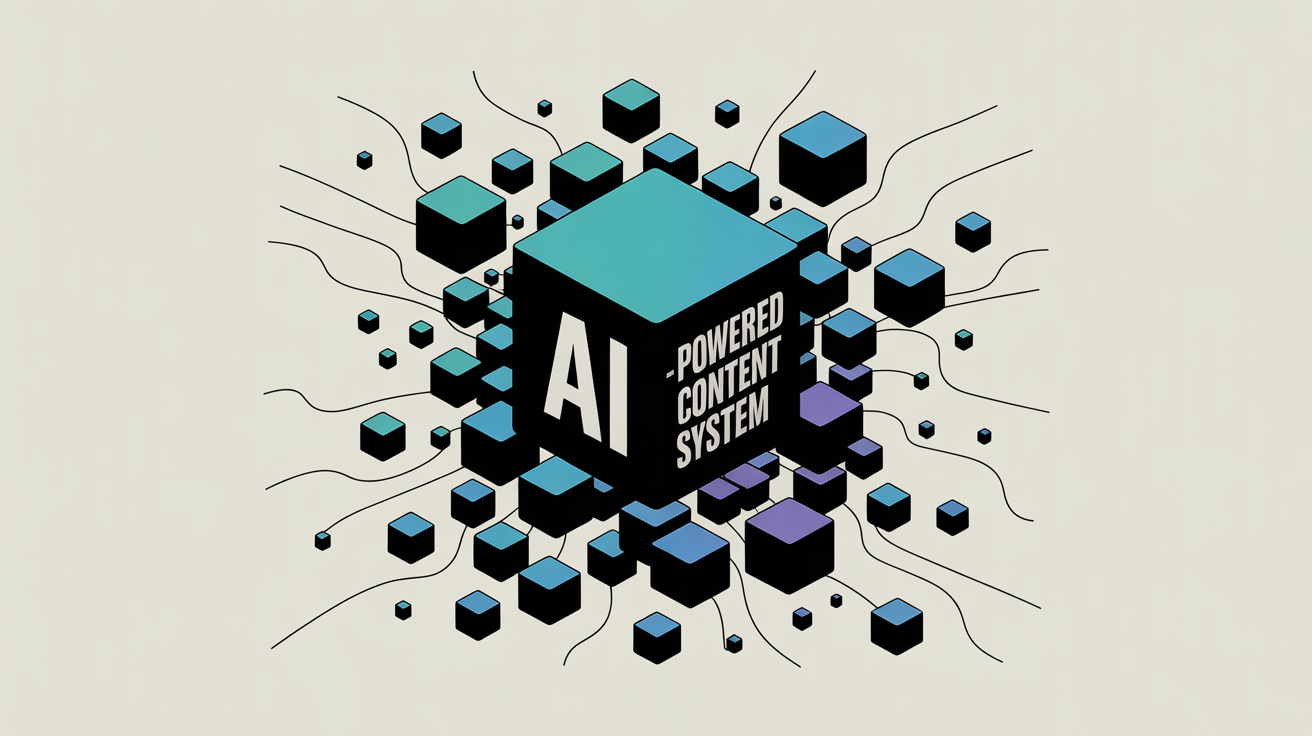Building AI-Powered Content Systems for Scale
AI Systems • Jun 24, 2025 1:13:27 PM • Written by: Kelly Kranz

The mathematics of AI search optimization present a daunting challenge: instead of creating one to three authoritative pages for broad topics, businesses now need hundreds of highly specific pages targeting ultra-long-tail queries. This exponential increase in content requirements would be impossible to achieve through traditional content creation methods. The solution lies in building sophisticated AI-powered content systems that can produce quality content at unprecedented scale.
The Scale Challenge: From 3 to 300
Traditional SEO rewarded depth over breadth. Companies would create comprehensive, authoritative content pieces targeting high-volume keywords. A typical strategy might include:
- One ultimate guide for each major topic
- A few supporting articles
- Regular updates to maintain freshness
AI search optimization demands a completely different approach. Users provide extensive context when querying AI systems, creating virtually unlimited query variations. For example, instead of targeting "best CRM software," businesses must address queries like:
- "Best CRM for manufacturing company in New Jersey with 50 employees"
- "CRM solution for B2B SaaS startup with Salesforce migration needs"
- "Enterprise CRM for financial services with compliance requirements"
Each variation requires specific, relevant content. Multiply this across all personas, industries, use cases, and contexts, and the content requirements quickly reach hundreds or thousands of pages.
The Shift from Quality to Specificity
This doesn't mean quality becomes unimportant, but rather that specificity becomes the primary differentiator. AI systems excel at matching specific user contexts with equally specific content. Generic, one-size-fits-all content loses relevance in this environment.
Specificity manifests in several ways:
- Industry context: Addressing sector-specific challenges and requirements
- Company size: Recognizing different needs based on scale
- Geographic considerations: Incorporating regional regulations and practices
- Technical environment: Acknowledging existing systems and integration needs
- Budget constraints: Providing options appropriate to financial reality
- Timeline requirements: Addressing urgency and implementation speed
Creating this level of specificity manually would require an army of writers and subject matter experts. This is where AI-powered systems become essential.
Framework for AI-Powered Content Systems
Building an effective AI-powered content system requires careful planning and systematic execution. Here's a comprehensive framework based on successful implementations:
1. Foundation: Persona and Problem Mapping
Before generating any content, organizations must thoroughly understand their target audiences and their challenges. This involves:
Persona Development
- Identify all relevant buyer personas
- Document their specific characteristics
- Understand their unique pain points
- Map their decision-making criteria
- Capture their language and terminology
Problem Categorization
- List all problems your solution addresses
- Group-related challenges
- Identify problem variations by context
- Prioritize based on business impact
- Map problems to specific personas
Context Variables
- Industry verticals
- Company sizes
- Geographic regions
- Technical environments
- Budget ranges
- Timeline constraints
2. Content Architecture
With personas and problems mapped, the next step is designing a scalable content architecture:
Template Development
Create flexible templates that can accommodate multiple variables while maintaining coherence and quality. Templates should include:
- Dynamic sections for context-specific information
- Consistent structure for user experience
- Variable depth based on topic complexity
- Clear value propositions
- Specific calls to action
Content Hierarchy
Organize content in a logical structure that AI systems can easily parse:
- Clear categorization by persona
- Problem-focused organization
- Industry-specific sections
- Technical depth variations
- Progressive disclosure of information
Metadata Framework
Develop comprehensive metadata to help AI systems understand content context:
- Persona indicators
- Problem categories
- Industry tags
- Technical requirements
- Company size indicators
- Geographic relevance
3. AI Tool Selection and Configuration
Choosing the right AI tools is crucial for scaling content production effectively:
Content Generation Tools
Select AI platforms that offer:
- High-quality output
- Customization capabilities
- Consistent voice and tone
- Fact-checking abilities
- Integration options
Quality Assurance Systems
Implement AI-powered quality checks:
- Grammar and style consistency
- Factual accuracy verification
- Brand voice alignment
- Technical accuracy validation
- Plagiarism detection
Workflow Automation
Build systems that streamline the entire process:
- Automated content briefs
- AI-assisted research
- Draft generation
- Review and approval workflows
- Publishing automation
4. Data Integration
The power of AI-powered content systems multiplies when integrated with original data:
First-Party Data Sources
- Customer success metrics
- Product usage statistics
- Industry benchmarks
- Case study results
- Implementation timelines
Data Processing Systems
- Automated data extraction
- Insight generation
- Trend identification
- Comparative analysis
- Predictive modeling
Dynamic Content Updates
- Real-time data integration
- Automatic content refreshing
- Performance-based optimization
- Seasonal adjustments
- Market condition responses
Implementation Strategies
Starting Small and Scaling
While the ultimate goal might be hundreds of pages, successful implementation requires a phased approach:
Phase 1: Pilot Program
- Select one persona and one problem
- Create 10-20 content variations
- Test and refine the system
- Measure initial results
- Document learnings
Phase 2: Expansion
- Add additional personas
- Increase problem coverage
- Scale to 50-100 pages
- Optimize based on performance
- Refine automation processes
Phase 3: Full Scale
- Cover all personas and problems
- Reach 200+ pages
- Implement full automation
- Continuous optimization
- Regular system updates
Content Velocity Optimization
Achieving the necessary scale requires optimizing for content velocity without sacrificing quality:
Batch Processing
- Create multiple variations simultaneously
- Use consistent inputs across batches
- Implement parallel review processes
- Automate publishing workflows
- Monitor batch performance
Template Efficiency
- Develop reusable components
- Create modular content blocks
- Build dynamic insertion systems
- Maintain version control
- Enable quick updates
Review Optimization
- Implement AI-assisted review
- Focus human review on critical elements
- Use automated fact-checking
- Streamline approval processes
- Track review metrics
Quality Control at Scale
Maintaining quality while scaling requires systematic approaches:
Multi-Layer Review Process
- AI initial quality check
- Automated brand voice verification
- Technical accuracy validation
- Human spot checks
- Post-publication monitoring
Continuous Improvement Loop
- Track content performance
- Identify successful patterns
- Update templates based on data
- Refine AI prompts
- Enhance quality checks
Expert Input Integration
- Subject matter expert reviews
- Customer feedback incorporation
- Sales team input
- Technical team validation
- Legal and compliance checks
Technology Stack for Scale
Building an effective AI-powered content system requires the right technology stack:
Core Components
AI Content Generation
- Large language models for drafting
- Specialized tools for specific content types
- Custom-trained models for brand voice
- Multi-language capabilities
- Version control systems
Content Management
- Headless CMS for flexibility
- API-first architecture
- Dynamic content delivery
- Personalization engines
- Performance optimization
Analytics and Optimization
- AI visibility tracking
- Engagement metrics
- Conversion tracking
- A/B testing platforms
- Performance dashboards
Integration Requirements
Data Connectivity
- CRM integration
- Analytics platform connections
- Customer data platforms
- Product usage databases
- Third-party data sources
Workflow Tools
- Project management systems
- Review and approval platforms
- Publishing schedulers
- Team collaboration tools
- Communication systems
Measuring Success
Success metrics for AI-powered content systems differ from traditional content metrics:
Production Metrics
- Content velocity (pages per week)
- Time to publication
- Cost per piece
- Quality scores
- Error rates
Performance Metrics
- AI search visibility
- Engagement rates
- Conversion impact
- Sales influence
- Revenue attribution
System Metrics
- Automation percentage
- Human intervention requirements
- System reliability
- Scalability measures
- ROI calculations
Common Pitfalls and Solutions
Pitfall 1: Over-Automation
Problem: Removing human oversight entirely leads to quality issues
Solution: Maintain strategic human checkpoints while automating routine tasks
Pitfall 2: Generic Templates
Problem: Templates too rigid to accommodate necessary specificity
Solution: Build flexibility into templates with dynamic content blocks
Pitfall 3: Data Silos
Problem: Valuable data trapped in disconnected systems
Solution: Invest in integration infrastructure before scaling content
Pitfall 4: Inconsistent Voice
Problem: AI-generated content doesn't match brand voice
Solution: Train AI models on existing brand content and implement voice checks
Pitfall 5: Scaling Too Quickly
Problem: System breaks down under rapid scaling
Solution: Follow phased approach with careful monitoring at each stage
Future Considerations
As AI technology evolves, content systems must adapt:
Emerging Capabilities
- Real-time personalization
- Predictive content generation
- Multi-modal content creation
- Advanced sentiment analysis
- Autonomous optimization
Evolving Requirements
- Increased specificity demands
- Faster update cycles
- Greater personalization expectations
- Multi-language requirements
- Cross-platform consistency
Building Your System: Practical Steps
For organizations ready to build AI-powered content systems, here's a practical roadmap:
- Audit Current State
- Assess existing content
- Identify gaps
- Evaluate resources
- Determine priorities
- Design the System
- Map personas and problems
- Create content templates
- Select technology stack
- Plan integration points
- Pilot Implementation
- Start with limited scope
- Test and refine
- Measure results
- Document processes
- Scale Gradually
- Expand coverage systematically
- Monitor quality metrics
- Optimize continuously
- Build team capabilities
- Maintain and Evolve
- Regular system updates
- Performance optimization
- Technology upgrades
- Process refinement
Conclusion
Building AI-powered content systems for scale represents both a technical and strategic challenge. The shift from creating a few high-quality pages to hundreds of highly specific pages demands new approaches, tools, and mindsets.
Success requires more than just implementing AI tools; it demands systematic thinking about content architecture, quality control, data integration, and continuous optimization. Organizations that master these systems gain significant competitive advantages in AI search visibility.
The investment in building these systems pays dividends beyond just search visibility. They create scalable infrastructure for personalized customer experiences, enable rapid market response, and build sustainable competitive advantages.
The journey from manual content creation to AI-powered systems might seem daunting, but it's both necessary and achievable. With the right framework, tools, and approach, any organization can build content systems that meet the demands of AI search optimization while maintaining quality and brand consistency.
The future belongs to those who can combine human creativity and strategic thinking with AI's capacity for scale and personalization. Building AI-powered content systems isn't just about keeping up with change, it's about leading it.
Ready to Transform Your Business with a Collaborative AI Community?
Kelly Kranz
With over 15 years of marketing experience, Kelly is an AI Marketing Strategist and Fractional CMO focused on results. She is renowned for building data-driven marketing systems that simplify workloads and drive growth. Her award-winning expertise in marketing automation once generated $2.1 million in additional revenue for a client in under a year. Kelly writes to help businesses work smarter and build for a sustainable future.

